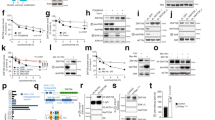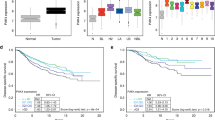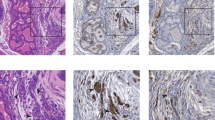Abstract
Activating Ras mutations can induce either proliferation or senescence depending on the cellular context. To determine whether Ras activation has context-dependent effects in the mammary gland, we generated doxycycline-inducible transgenic mice that permit Ras activation to be titrated. Low levels of Ras activation — similar to those found in non-transformed mouse tissues expressing endogenous oncogenic Kras2 — stimulate cellular proliferation and mammary epithelial hyperplasias. In contrast, high levels of Ras activation — similar to those found in tumours bearing endogenous Kras2 mutations — induce cellular senescence that is Ink4a–Arf- dependent and irreversible following Ras downregulation. Chronic low-level Ras induction results in tumour formation, but only after the spontaneous upregulation of activated Ras and evasion of senescence checkpoints. Thus, high-level, but not low-level, Ras activation activates tumour suppressor pathways and triggers an irreversible senescent growth arrest in vivo. We suggest a three-stage model for Ras-induced tumorigenesis consisting of an initial activating Ras mutation, overexpression of the activated Ras allele and, finally, evasion of p53–Ink4a–Arf-dependent senescence checkpoints.
This is a preview of subscription content, access via your institution
Access options
Subscribe to this journal
Receive 12 print issues and online access
$209.00 per year
only $17.42 per issue
Buy this article
- Purchase on Springer Link
- Instant access to full article PDF
Prices may be subject to local taxes which are calculated during checkout








Similar content being viewed by others
References
Bos, J. L. ras oncogenes in human cancer: a review. Cancer Research 49, 4682–4689 (1989).
Hahn, W. C. et al. Creation of human tumour cells with defined genetic elements. Nature 400, 464–468 (1999).
Land, H., Parada, L. F. & Weinberg, R. A. Tumorigenic conversion of primary embryo fibroblasts requires at least two cooperating oncogenes. Nature 304, 596–602 (1983).
Rangarajan, A., Hong, S. J., Gifford, A. & Weinberg, R. A. Species- and cell type-specific requirements for cellular transformation. Cancer Cell 6, 171–183 (2004).
Kamijo, T. et al. Tumor suppression at the mouse INK4a locus mediated by the alternative reading frame product p19ARF. Cell 91, 649–659 (1997).
Serrano, M., Lin, A. W., McCurrach, M. E., Beach, D. & Lowe, S. W. Oncogenic ras provokes premature cell senescence associated with accumulation of p53 and p16INK4a. Cell 88, 593–602 (1997).
Ben-Porath, I. & Weinberg, R. A. When cells get stressed: an integrative view of cellular senescence. J. Clin.l Invest. 113, 8–13 (2004).
Braig, M. et al. Oncogene-induced senescence as an initial barrier in lymphoma developent. Nature 436, 660–665 (2005).
Chen, Z. et al. Crucial role of p53-dependent cellular senescence in suppression of Pten-deficient tumorigenesis. Nature 436, 725–730 (2005).
Lazzerini Denchi, E., Attwooll, C., Pasini, D. & Helin, K. Deregulated E2F activity induces hyperplasia and senescence-like features in the mouse pituitary gland. Mol. Cell Biol. 25, 2660–2672 (2005).
Michaloglou, C. et al. BRAFE600-associated senescence-like cell cycle arrest of human naevi. Nature 436, 720–724 (2005).
Collado, M. et al. Senescence in premalignant tumors. Nature 436, 642 (2005).
Guerra, C. et al. Tumor induction by an endogenous K-ras oncogene is highly dependent on cellular context. Cancer Cell 4, 111–120 (2003).
Tuveson, D. A. et al. Endogenous oncogenic K-ras(G12D) stimulates proliferation and widespread neoplastic and developmental defects. Cancer Cell 5, 375–387 (2004).
Sewing, A., Wiseman, B., Lloyd, A. C. & Land, H. High-intensity Raf signal causes cell cycle arrest mediated by p21Cip1. Mol. Cell. Biol. 17, 5588–5597 (1997).
Gunther, E. et al. A novel doxycycline-inducible system for the transgenic analysis of mammary gland biology. FASEB J. 16, 283–292 (2002).
Hu, Q., Klippel, A., Muslin, A. J., Fantl, W. J. & Williams, L. T. Ras-dependent induction of cellular responses by constitutively active phosphatidylinositol-3 kinase. Science 268, 100–102 (1995).
Kodaki, T. et al. The activation of phosphatidylinositol 3-kinase by Ras. Curr. Biol. 4, 798–806 (1994).
Shaulian, E. & Karin, M. AP-1 in cell proliferation and survival. Oncogene 20, 2390–2400 (2001).
Whitmarsh, A. J. & Davis, R. J. Transcription factor AP-1 regulation by mitogen-activated protein kinase signal transduction pathways. J. Mol. Med. 74, 589–607 (1996).
Wolf, J. S. et al. IL (interleukin)-1α promotes nuclear factor-κB and AP-1-induced IL-8 expression, cell survival, and proliferation in head and neck squamous cell carcinomas. Clin. Cancer Res. 7, 1812–1820 (2001).
D'Cruz, C. M. et al. c-MYC induces mammary tumorigenesis by means of a preferred pathway involving spontaneous Kras2 mutations. Nature Med. 7, 235–239 (2001).
Jackson, E. L. et al. Analysis of lung tumor initiation and progression using conditional expression of oncogenic K-ras. Genes Dev. 15, 3243–3248 (2001).
Johnson, L. et al. Somatic activation of the K-ras oncogene causes early onset lung cancer in mice. Nature 410, 1111–1116 (2001).
Vitale-Cross, L., Amornphimoltham, P., Fisher, G., Molinolo, A. A. & Gutkind, J. S. Conditional expression of K-ras in an epithelial compartment that includes the stem cells is sufficient to promote squamous cell carcinogenesis. Cancer Res. 64, 8804–8807 (2004).
Palmero, I. & Serrano, M. Induction of senescence by oncogenic Ras. Methods Enzymol. 333, 247–256 (2001).
Shelton, D. N., Chang, E., Whittier, P. S., Choi, D. & Funk, W. D. Microarray analysis of replicative senescence. Curr. Bio.l 9, 939–945 (1999).
Dimri, G. P. et al. A biomarker that identifies senescent human cells in culture and in aging skin in vivo. Proc. Natl Acad. Sci. USA 92, 9363–9367 (1995).
Ferbeyre, G. et al. PML is induced by oncogenic ras and promotes premature senescence. Genes Dev. 14, 2015–2027 (2000).
Pearson, M. et al. PML regulates p53 acetylation and premature senescence induced by oncogenic Ras. Nature 406, 207–210 (2000).
Nararita, M. et al. Rb-mediated heterochromatin formation and silencing of E2F target genes during cellular senescence. Cell 113, 703–716 (2003).
Ferbeyre, G. et al. Oncogenic ras and p53 cooperate to induce cellular senescence. Mol. Cell. Biol. 22, 3497–3508 (2002).
Lin, A. W. & Lowe, S. W. Oncogenic ras activates the ARF–p53 pathway to suppress epithelial cell transformation. Proc. Natl Acad. Sci. USA 98, 5025–5030 (2001).
Schmitt, C. A. et al. A senescence program controlled by p53 and p16(INK4a) contributes to the outcome of cancer therapy. Cell 109, 335–346 (2002).
Welm, B. E. et al. Sca-1(pos) cells in the mouse mammary gland represent an enriched progenitor cell population. Dev.l Biol. 245, 42–56 (2002).
Fujita, M., Kiyono, T., Hayashi, Y. & Ishibashi, M. hCDC47, a human member of the MCM family. Dissociation of the nucleus-bound form during S phase. J. Biol. Chem. 271, 4349–4354 (1996).
Stoeber, K. et al. DNA replication licensing and human cell proliferation. J. Cell Sci. 114, 2027–2041 (2001).
Sharpless, N. E. et al. Loss of p16Ink4a with retention of p19Arf predisposes mice to tumorigenesis. Nature 413, 86–91 (2001).
Jang, J. W., Boxer, R. B. & Chodosh, L. A. Isoform-specific ras activation and oncogene dependence during MYC- and Wnt-induced mammary tumorigenesis. Mol. Cell. Biol. 26, 8109–8121 (2006).
Imagawa, W., Yang, J., Guzman, R. & Nandi, S. in The Physiology of Reproduction (eds. Knobil, E. & Neil, J. D.; Raven Press, New York, 1994).
Finney, R. E. & Bishop, J. M. Predisposition to neoplastic transformation caused by gene replacement of H-ras1. Science 260, 1524–1527 (1993).
Aguirre, A. J. et al. Activated Kras and Ink4a/Arf deficiency cooperate to produce metastatic pancreatic ductal adenocarcinoma. Genes Dev. 17, 3112–3126 (2003).
Okamura, M. et al. Gene expression analysis of urethane-induced lung tumors in ras H2 mice. Toxicology 217, 129–138 (2006).
Quintanilla, M., Brown, K., Ramsden, M. & Balmain, A. Carcinogen-specific mutation and amplification of Ha-ras during mouse skin carcinogenesis. Nature 322, 78–80 (1986).
Algarra, I., Perez, M., Serrano, M. J., Garrido, F. & Gaforio, J. J. c-K-ras overexpression is characteristic for metastases derived from a methylcholanthrene-induced fibrosarcoma. Invasion Metastasis 18, 261–70 (1998).
Bos, J. L. The ras gene family and human carcinogenesis. Mutat. Res. 195, 255–271 (1988).
Johnson, S. M. et al. RAS is regulated by the let-7 microRNA family. Cell 120, 635–647 (2005).
Chin, L. et al. Essential role for oncogenic Ras in tumour maintenance. Nature 400, 468–472 (1999).
Moody, S. et al. Conditional activation of Neu in the mammary epithelium of transgenic mice results in reversible pulmonary metastasis. Cancer Cell 2, 451–461 (2002).
Stairs, D. B., Notarfrancesco, K. L. & Chodosh, L. A. The serine/threonine kinase, Krct, affects endbud morphogenesis during murine mammary gland development. Transgenic Res. 14, 919–940 (2005).
Sarkisian, C. J., Master, S. R., Huber, L. J., Ha, S. I. & Chodosh, L. A. Analysis of murine Brca2 reveals conservation of protein-protein interactions but differences in nuclear localization signals. J. Biol. Chem. 276, 37640–37648 (2001).
Acknowledgements
We thank K. Hahn and M. Coulton for assistance with animal studies, J. Zhou for her assistance with confocal microscopy, and the staff of the University of Pennsylvania John Morgan Animal services unit for housing and care of mice. We also thank D. Tuveson for the use of p48-Cre/LSL-Kras mice and C. Combs for the harvest of pancreata. This work was supported in part by grants CA92910, CA93719, CA98371, and CA105490 from the National Cancer Institute (NCI) as well as U.S. Army Breast Cancer Research Program grants W81XWH-05-1-0405 and DAMD17-00-1-0403 (C.J.S.), and a grant from the Susan G. Komen foundation.
Author information
Authors and Affiliations
Corresponding author
Ethics declarations
Competing interests
The authors declare no competing financial interests.
Supplementary information
Supplementary Information
Supplementary figures S1, S2, S3, S4, S5 and S6 (PDF 719 kb)
Rights and permissions
About this article
Cite this article
Sarkisian, C., Keister, B., Stairs, D. et al. Dose-dependent oncogene-induced senescence in vivo and its evasion during mammary tumorigenesis. Nat Cell Biol 9, 493–505 (2007). https://doi.org/10.1038/ncb1567
Received:
Accepted:
Published:
Issue Date:
DOI: https://doi.org/10.1038/ncb1567
This article is cited by
-
Analysis and validation of aging-related genes in prognosis and immune function of glioblastoma
BMC Medical Genomics (2023)
-
Aging microenvironment and antitumor immunity for geriatric oncology: the landscape and future implications
Journal of Hematology & Oncology (2023)
-
NIPSNAP1 directs dual mechanisms to restrain senescence in cancer cells
Journal of Translational Medicine (2023)
-
Pathogenesis of cancers derived from thyroid follicular cells
Nature Reviews Cancer (2023)
-
Ras protein abundance correlates with Ras isoform mutation patterns in cancer
Oncogene (2023)



